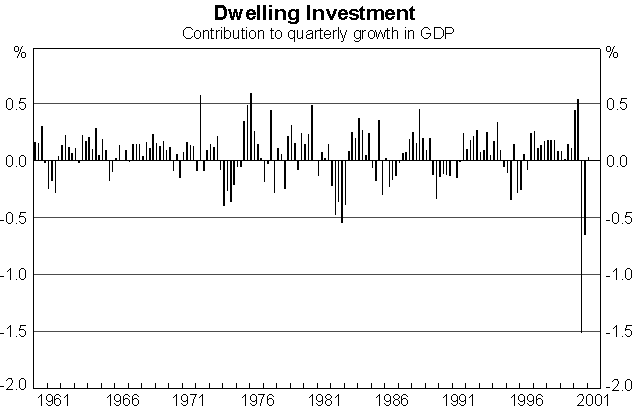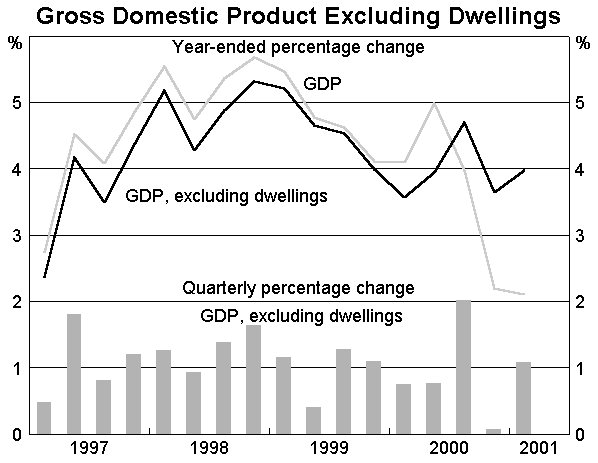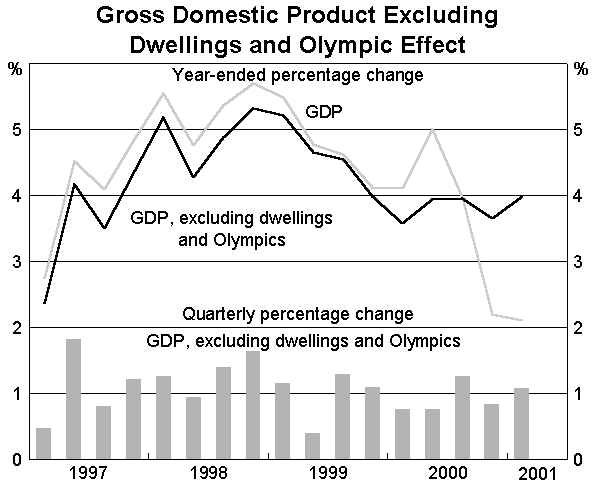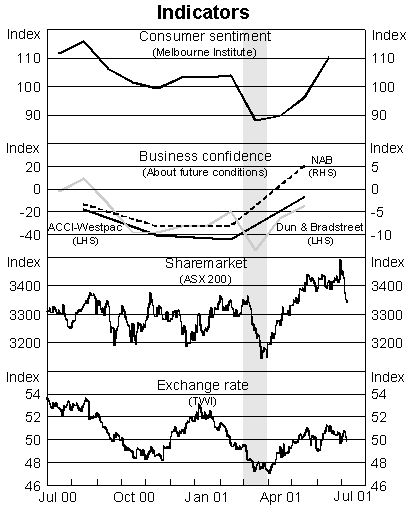Speech Economic Developments at Home and Abroad

I.J. Macfarlane
Governor
Talk to Joint Australian Business Economists & Economic Society
(New South Wales Branch) Dinner
Sydney –
It is a pleasure to be here again talking to the Australian Business Economists and the Economic Society. On occasions like this, I often feel it would be nice to be able to speak in a detached way on some interesting public policy or historical topic. But in periods where the domestic and world economies are evolving quite quickly, current economic developments keep pushing their way to the front. So I will have to save my more scholarly piece for another day, and confine my remarks tonight to some observations on recent economic events here and abroad.
I would like to take as my starting point the way we viewed the economic outlook for Australia about a year ago, that is, as we were entering the 2000/01 financial year. At that time, there were two main components to our view of the economic outlook. The first was a view on the medium-term cyclical development of the economy, which was predominantly optimistic. The second was a view about the effect of ‘once-off’ events such as the introduction of the GST and the Sydney Olympics on the financial year 2000/01; here, the tone was one of uncertainty. I would now like to spell out how these two overlapping views have fared in the light of unfolding developments.
1. The Medium-term Cyclical Outlook
For some years now, we have pointed to the prospect of achieving a longer economic expansion if the economy can be managed in a way which avoids the type of imbalances that have brought about our downfall in the past. By the middle of last year, we were able to point out that it had already happened, in that the present expansion was already longer than its predecessors. But we were saying more than this – we were saying that, even though it was longer, it still had not shown any of the imbalances that characterised the latter stages of earlier expansions:
- although inflation of goods and services prices had risen, it was not by enough to threaten our medium-term objective;
- asset price inflation of either shares or property had not become a problem;
- wages growth remained moderate;
- there had not been excessive physical investment with its attendant risk of over-capacity; and
- the current account deficit was not high by the standards of the past 20 years, and falling quickly.
For these reasons (and for others that I will come to later), we always felt optimistic about our medium-term economic prospects. This does not mean that we felt that the strong expansion of the 1990s could continue indefinitely at the average growth rate we were then recording. We were conscious that the business cycle, whether domestic or international, has not been eliminated, even though it may have been ameliorated. This meant that slower growth was to be expected as the cycle unfolded. But we did feel that there was no domestic reason why the economy should undergo anything more serious than a moderate slowing phase within the general context of continued expansion.
Of course, we recognised that we were not immune to developments in the rest of the world. To the extent that there was a risk of something more serious than a moderate slowing of the Australian economy, we identified that risk as coming from overseas. But even here there was an element of optimism in that we felt that in the event of a world downturn, we would be affected less and later than most other countries because of the resilience of our economy I have just outlined. I now turn to the second component of our view referred to earlier.
2. ‘Once-off’ Developments in 2000/01
Everyone knew that developments in 2000/01, particularly the first half, were going to be difficult to forecast and interpret. This was because economic statistics would be very ‘lumpy’ as they reflected the introduction of the GST on 1 July, and the holding of the Olympic Games at the end of the September quarter. The introduction of the GST, and associated changes to other taxes, was a major event – structural changes of this type are likely to occur only once in a decade, or even once in a generation, and so are always difficult to forecast. Economists had very little to go on in assessing the likely effects, but we all tried to do so by looking at the experience of other countries that had made a similar change. This was not a lot of help, and no-one could be confident what the main effect would be. Judging from the questioning I received during this period, the most likely effect was thought to be on inflation, with shifts in consumption being the other factor most often mentioned. I am not aware of anyone who thought that house-building would be the main area affected, although everyone expected a decline.
3. What Happened?
In the event, the major transition effect of the GST was to bring about a fall in house-building in the second half of 2000 that was much bigger than anyone had forecast or we had ever previously experienced (Graph 1). While house-building only comprises 5 per cent of GDP, its fall of 37 per cent in two quarters was enough to outweigh reasonably healthy growth in the other 95 per cent of the economy, and so produce a contraction in GDP for the half-year.

There were other factors at work as well, for example, the rising oil price, and there were other parts of the economy that were affected, for example, the labour market. But the figures clearly show that the fall in house-building subtracted 2.2 percentage points from the half-year's GDP growth, and hence accounted for the overall contraction in economic activity (Graph 2). This was a transition effect of the GST, which would soon reverse, and therefore should, in principle, have no effect on our average prospects over the medium term. The problem with transition effects, however, is that they can affect people's confidence and their expectations because at the time no-one can be sure they are transitory. This happened on this occasion as business confidence fell, although not precipitously, over the second half of 2000.


When the decline in GDP was revealed in early March, confidence took a sharper turn for the worse. Not only did business confidence fall further, but consumer confidence and the exchange rate joined in, and the share market did not escape without damage. This was a period of considerable gloom, when some observers went so far as to suggest that Australia might talk itself into recession. In terms of the two components of our view, the second seemed to have completely eclipsed the first, and you could be forgiven for believing that there was no longer any substance to the first view.

What we now know is that at precisely the time that confidence was reaching its low point – the March quarter of 2001 – the transitional effects were dropping out of the calculations and the economy was returning to reasonable growth. The March quarter national accounts show this clearly, and a range of other indicators show a distinct improvement from their March low point (Graph 3).
- Consumer sentiment, although declining in the second half of 2000, had remained above its long-term average until it fell sharply in March. It has now regained a level above its long-term average.
- The share market has been generally very buoyant by world standards, but fell by 6 per cent in March before recovering in April and May.
- The exchange rate reacted to the weak economic activity news and reached a low point in early April. It subsequently rose by 7 per cent against the US dollar and in trade-weighted terms.
- There is evidence from a number of business survey responses to questions about the economic outlook that confidence has improved.
4. Where Does That Leave Us?
My assessment is that we are now back in a position where the first view represents a good summary of our position. The major threat to our future growth prospects now comes from the international economy, not from domestic factors. The list of domestic factors which provided underlying resilience a year ago still applies. And we could add to that list the fact that monetary policy and fiscal policy have both moved in an expansionary direction since then, and that the exchange rate continues to provide stimulus to the internationally traded sector.
Before moving on to discuss the world economy, I would like to touch on one further question pertaining to the domestic economy. The question is the following: Does the fact that we had such a poor second half of 2000 put us in a worse or a better position to handle any future weakness in the world economy? On the surface of it, you might be inclined to say that it has made things more difficult for us because it has given us a weaker starting point. On the other hand, you could mount a defensible case that it may help us in the medium term. First, we have now got some of the usual cyclical contractionary forces behind us, which in a more normal business cycle we might still be facing. The housing contraction is the most obvious of these, but the inventory cycle has also been probably brought forward and therefore may be already half completed. Second, the greater and earlier-than-expected weakening of the domestic economy focussed the attention of policy makers on the need for easing somewhat earlier in the process than if the cycle had had a more normal shape. On monetary policy it is hard to be definite on this point, because other important factors were also at work – for example, the recognition that the international cycle was turning and that inflation remained low – but, at the margin, the weakness in the second half of 2000 contributed to an earlier easing. On fiscal policy, the increase in the first home buyers' grant is an example. Finally, the perception of weakness in the Australian economy probably contributed to holding down the value of the Australian dollar. I do not want to make too much out of these arguments, other than to point out that some clouds do have silver linings.
5. The International Economy
When we think of the international economy, or its leading member – the US economy – we tend to remember that there has been a reasonably pronounced business cycle over recent decades. Recessions occurred in the mid seventies, the early eighties and the early nineties. A lot of people think in terms of a relatively regular cycle, and hence think we are due for another US and world recession now. We cannot summarily dismiss this simple approach, and I find it hard to argue against the view that economies contain some unavoidable element of cyclicality in their path of development. The issues are: Does a cycle necessarily involve a recession, and are there characteristics of the current cycle that make it different to its predecessors? I think these can be answered together.
The current international cycle is different to its predecessors in one extremely important respect – the expansion phase did not culminate in an excessive rise in inflation. In fact, the rise in inflation was quite modest. This had two important consequences. First, because the rise in inflation was small, interest rates did not need to rise by very much during the relatively short period that they had to perform their anti-inflationary task. (Table 1 looks at the peak in inflation and interest rates at the end of various expansions.) Second, monetary policy could be eased much earlier in the slowing phase of the cycle than in the past. Thus, to the extent that the cycle is the result of changes in monetary conditions and monetary policy, it should unambiguously be more muted on this occasion. Similarly, to the extent that major downturns are the result of financial fragility, the situation should be better on this occasion as financial intermediaries in virtually all western countries are in much sounder shape than a decade ago. Thus, in the areas dear to a central banker's heart – monetary and financial stability – the situation is appreciably better on this occasion than earlier ones.
| OECD inflation (year-ended) |
G3 nominal policy interest rate | |
|---|---|---|
| 1970s peak | 14.8 | 10.6 |
| 1980s peak | 13.1 | 14.1 |
| early 1990s peak | 5.7 | 8.4 |
| 2000 peak (a) | 3.2 | 5.8 |
| (a) Excluding Japan | ||
It would be very reassuring if this were the end of the story for the world economy, but it would be too simple. There clearly are some important imbalances we still have to contend with, particularly in the United States. The most often mentioned of these are high share prices, the high US dollar and an overhang of capital expenditure, particularly in technology. It is worth looking a little more closely at them.
When share prices were on the way up, and setting new highs for the price-earning-ratio, many people were expecting that this would eventually be followed by a crash like 1987, if not one of 1929 proportions. That scenario seems less likely now that we have about 15 months of correction behind us. While the fall in the NASDAQ was large enough (70 per cent) to warrant the term ‘crash’, and its preceding rise the term ‘bubble’, the share market as a whole has retreated in a more orderly fashion. The fall in the broad indices such as the S&P 500 or the Wilshire has been about 20 per cent over the past 15 months, and the price-earning-ratio has come down from a peak of 36 to 26. Now, I do not want to get into the business of forecasting future share prices – the only point I wish to make is that the risk of a fall severe enough to frighten people into stopping spending must be smaller now that we have some of the correction behind us, than when we had none.
The high level of the US dollar, and the fact that it is still tending to rise, cannot be helpful to the US economy. It must be harming US exporters and those who compete with imports, and no doubt is one of the reasons why US manufacturing output has fallen for each of the past eight months. But these effects on trade flows, while unhelpful to the United States, must be helpful to its trading partners including ourselves. So it is hard to see the trade effects of the strong US dollar being harmful to the world economy as a whole. Where the rising dollar is harmful is in reinforcing the widely held view that you cannot go wrong in buying US assets – if their value goes down, at least you will gain on the exchange rate. This sort of thinking does distort capital flows and can lead to misalignments in asset markets.
The area where I think a US imbalance is having unfortunate consequences both inside and outside the United States is in physical investment. In the year to June 1999, equipment investment grew by 13 per cent, and by 16 per cent in the year to June 2000. In the same two years, investment in high technology products grew by over 23 per cent and 27 per cent. Whenever there is an extremely fast growth of investment, there is always the danger that excess capacity has been put in place and that the necessary correction will involve a period of sharply declining investment. That is happening now with US equipment investment declining by 2.3 per cent in the most recent quarter, and investment in technology by 10 per cent. These cutbacks have had a big effect on Asia where exports of electronic equipment have fallen by 25 per cent, which helps explain why Asian GDP growth has flattened out over recent quarters. Of course, this is a purely cyclical event, and will reverse in time, but it is an important channel whereby a US imbalance transmits itself to the world economy.
While there are obvious imbalances in the US economy as outlined above, I would judge them to be smaller in aggregate than at a similar stage of earlier cycles, particularly if we give a lot of weight to inflation and financial stability. Japan is in a weak state as it has been on several occasions over the past decade and its outlook is not improving. Europe has also slowed, but no obvious imbalances of the US type have emerged. We are presently in a period of sub-par growth for all three areas, and this is inevitably a time of great uncertainty. Even though I expect the world economy to do better than it did a decade ago, we can probably expect to hear some more bad news before the better news arrives.
Conclusion
I hope what I have said tonight has been reasonably even-handed. While I note that money markets have recently become more optimistic about our outlook, I think for most people the main unanswered question is still whether the world economy is going to face something materially worse than a period of slow growth over the coming year. The substance of what I have said tonight is that, while such an outcome cannot be ruled out, its likelihood is lower than it appeared at the turn of the year, or as recently as March this year. When these downside risks were mounting earlier in the year, we were prepared to ease monetary policy reasonably quickly and by a significant amount. If the outlook I have sketched comes to pass, further such decisive action may not be necessary. If the alternative occurs and significant downside risks re-emerge, we will not hold back from further action.